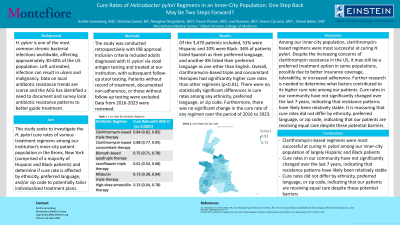Monday Poster Session
Category: Stomach
P2744 - Cure Rates of Helicobacter pylori Regimens in an Inner-City Population: One Step Back May Be Two Steps Forward?
Monday, October 23, 2023
10:30 AM - 4:15 PM PT
Location: Exhibit Hall

Has Audio

Arielle Greenberg, MD
Montefiore Medical Center
Bronx, NY
Presenting Author(s)
Arielle Greenberg, MD1, Nicholas Samel, BS2, Meaghan Mcgoldrick, MD1, Trevor Plumer, MD1, Joel Rosiene, MD1, Gianni Carrozzi, MD1, Daniel Behin, MD1
1Montefiore Medical Center, Bronx, NY; 2Albert Einstein College of Medicine, Bronx, NY
Introduction: H. pylori is one of the most common chronic bacterial infections worldwide affecting approximately 30-40% of the US population. Left untreated, infection can result in ulcers and malignancy. Data on local antibiotic resistance trends is scarce and the ACG has identified a need to document and survey local antibiotic resistance patterns to better guide treatment. This study seeks to investigate the H. pylori cure rates (CR) of various treatment regimens among our institution’s inner-city patient population in the Bronx, NY, comprised of majority Hispanic and Black patients, and determine if CR is affected by ethnicity, preferred language, and/or zip code to potentially tailor individualized treatment plans.
Methods: The study was conducted retrospectively with IRB approval. Inclusion criteria included adults diagnosed with H. pylori via stool antigen testing, treated at our institution, with subsequent follow up testing. Patients without record of treatment, documented non-adherence, or those without follow up testing were excluded. Data from 2016-2023 were reviewed.
Results: Of the 3,470 patients included, 52% were Hispanic and 20% were Black. 36% of patients listed Spanish as their preferred language, and another 8% listed their preferred language as one other than English. Overall, clarithromycin based triple and concomitant therapies had significantly higher CR than other regimens, with 84% and 88% of patients cured respectively (p< 0.01). Bismuth based quadruple therapy had a CR of 75% and other regimens had CRs ranging from 33-73%. There were no statistically significant differences in CR among any ethnicity, preferred language, or zip code. Furthermore, there was no significant change in the CR of any regimen over the period of 2016 to 2023.
Discussion: Among our inner-city population, clarithromycin based regimens were most successful at curing H. pylori. Despite the increasing concerns of clarithromycin resistance in the US, it may still be a preferred treatment option in some populations, possibly due to better insurance coverage, tolerability, or increased adherence. Further research is needed to determine what factors contributed to its higher CR among our patients. CRs in our community have not significantly changed over the last 7 years, indicating that resistance patterns have likely been relatively stable. It is reassuring that CR did not differ by ethnicity, preferred language, or zip code, indicating that our patients are receiving equal care despite potential barriers.
Disclosures:
Arielle Greenberg, MD1, Nicholas Samel, BS2, Meaghan Mcgoldrick, MD1, Trevor Plumer, MD1, Joel Rosiene, MD1, Gianni Carrozzi, MD1, Daniel Behin, MD1. P2744 - Cure Rates of Helicobacter pylori Regimens in an Inner-City Population: One Step Back May Be Two Steps Forward?, ACG 2023 Annual Scientific Meeting Abstracts. Vancouver, BC, Canada: American College of Gastroenterology.
1Montefiore Medical Center, Bronx, NY; 2Albert Einstein College of Medicine, Bronx, NY
Introduction: H. pylori is one of the most common chronic bacterial infections worldwide affecting approximately 30-40% of the US population. Left untreated, infection can result in ulcers and malignancy. Data on local antibiotic resistance trends is scarce and the ACG has identified a need to document and survey local antibiotic resistance patterns to better guide treatment. This study seeks to investigate the H. pylori cure rates (CR) of various treatment regimens among our institution’s inner-city patient population in the Bronx, NY, comprised of majority Hispanic and Black patients, and determine if CR is affected by ethnicity, preferred language, and/or zip code to potentially tailor individualized treatment plans.
Methods: The study was conducted retrospectively with IRB approval. Inclusion criteria included adults diagnosed with H. pylori via stool antigen testing, treated at our institution, with subsequent follow up testing. Patients without record of treatment, documented non-adherence, or those without follow up testing were excluded. Data from 2016-2023 were reviewed.
Results: Of the 3,470 patients included, 52% were Hispanic and 20% were Black. 36% of patients listed Spanish as their preferred language, and another 8% listed their preferred language as one other than English. Overall, clarithromycin based triple and concomitant therapies had significantly higher CR than other regimens, with 84% and 88% of patients cured respectively (p< 0.01). Bismuth based quadruple therapy had a CR of 75% and other regimens had CRs ranging from 33-73%. There were no statistically significant differences in CR among any ethnicity, preferred language, or zip code. Furthermore, there was no significant change in the CR of any regimen over the period of 2016 to 2023.
Discussion: Among our inner-city population, clarithromycin based regimens were most successful at curing H. pylori. Despite the increasing concerns of clarithromycin resistance in the US, it may still be a preferred treatment option in some populations, possibly due to better insurance coverage, tolerability, or increased adherence. Further research is needed to determine what factors contributed to its higher CR among our patients. CRs in our community have not significantly changed over the last 7 years, indicating that resistance patterns have likely been relatively stable. It is reassuring that CR did not differ by ethnicity, preferred language, or zip code, indicating that our patients are receiving equal care despite potential barriers.
Disclosures:
Arielle Greenberg indicated no relevant financial relationships.
Nicholas Samel indicated no relevant financial relationships.
Meaghan Mcgoldrick indicated no relevant financial relationships.
Trevor Plumer indicated no relevant financial relationships.
Joel Rosiene indicated no relevant financial relationships.
Gianni Carrozzi: Abbot – Stock-publicly held company(excluding mutual/index funds). J and J – Stock-publicly held company(excluding mutual/index funds). Novo Nordisk – Stock-publicly held company(excluding mutual/index funds). Pfizer – Stock-publicly held company(excluding mutual/index funds).
Daniel Behin indicated no relevant financial relationships.
Arielle Greenberg, MD1, Nicholas Samel, BS2, Meaghan Mcgoldrick, MD1, Trevor Plumer, MD1, Joel Rosiene, MD1, Gianni Carrozzi, MD1, Daniel Behin, MD1. P2744 - Cure Rates of Helicobacter pylori Regimens in an Inner-City Population: One Step Back May Be Two Steps Forward?, ACG 2023 Annual Scientific Meeting Abstracts. Vancouver, BC, Canada: American College of Gastroenterology.
